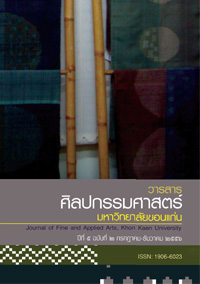แบบประเมินตนเองแบบภาพรวมโดยการบันทึกวีดิทัศน์ สำหรับวิชาขับร้องในระดับชั้นต้น: กรณีศึกษาโรงเรียนดนตรีมีฟ้า
Main Article Content
Abstract
การวิจัยเรื่องแบบประเมินตนเองแบบภาพรวมโดยการบันทึกวีดิทัศน์ สำหรับวิชาขับร้องในระดับชั้นต้น กรณีศึกษา โรงเรียนดนตรีมีฟ้า มีวัตถุประสงค์ดังนี้ (1) เพื่อสร้างแบบประเมินตนเองแบบภาพรวม สำหรับนักเรียนวิชาขับร้อง ระดับชั้น ต้น (2) เพื่อศึกษาประสิทธิภาพแบบประเมินตนเองแบบภาพรวม สำหรับนักเรียนวิชา ขับร้องระดับชั้นต้น (3) เพื่อศึกษาผลสัมฤทธิ์ทางการเรียน โดยใช้แบบประเมินตนเอง แบบภาพรวม สำหรับนักเรียนวิชาขับร้องระดับชั้นต้น ซึ่งกลุ่มตัวอย่างในครั้งนี้ได้แก่ นักเรียนวิชาขับร้องในระดับชั้นต้น ของโรงเรียนดนตรีมีฟ้าที่เรียนมาแล้ว 10 – 20 ชั่วโมง จำนวน 10 คน
เครื่องมือที่ใช้ในการวิจัยในครั้งนี้ ประกอบด้วย (1) แบบประเมินตนเอง แบบภาพรวมโดยการบันทึกวีดิทัศน์สำหรับนักเรียนวิชาขับร้องในระดับชั้นต้นก่อน เรียนและหลังเรียน (2) เอกสารการทบทวนหลักการขับร้องเบื้องต้น มีทั้งหมด 5 หัวข้อคือ ลักษณะท่ายืนในการร้องเพลง การหายใจ การเปล่งเสียง การออกเสียง อักขระ และการวิเคราะห์เนื้อหาของบทเพลง (3) แบบฝึกหัดการขับร้องในระดับชั้น ต้นระหว่างเรียน (4) การบันทึกวีดิทัศน์ โดยสถิติที่ใช้ในการวิเคราะห์ข้อมูลคือ สถิติ พรรณนา ได้แก่ ค่าร้อยละ ค่าเฉลี่ย ส่วนเบี่ยงเบนมาตรฐาน และสถิติอ้างอิงในการ เปรียบเทียบผลสัมฤทธิ์ทางการศึกษา คือ การทดสอบค่า t (t-test)
ผลการวิจัยพบว่า (1) แบบประเมินตนเองแบบภาพรวมโดยการบันทึก วีดิทัศน์ สำหรับนักเรียนวิชาขับร้องในระดับชั้นต้น ประกอบด้วยเนื้อหาการขับร้อง เบื้องต้น 5 หัวข้อคือ ลักษณะท่ายืนในการร้องเพลง การหายใจ การเปล่งเสียง การออกเสียงให้ถูกต้องตามอักขระวิธี และการวิเคราะห์เนื้อหาของบทเพลง โดยได้ กำหนดช่วงชั้นความสามารถไว้ทั้งหมด 4 ช่วงชั้น แต่ละช่วงชั้นมีคะแนนที่ระบุอยู่ใน รูปแบบจำนวนดาวคือ 1 - 4 ดาว ซึ่งมีค่าดรรชนีความสอดคล้องระหว่าง 0.6 - 1 (2) แบบประเมินตนเองแบบภาพรวมโดยการบันทึกวีดิทัศน์ สำหรับวิชาขับร้องใน ระดับชั้นต้น มีคะแนนเฉลี่ยระหว่างเรียน และ คะแนนเฉลี่ยหลังเรียนเท่ากับร้อยละ 88.32/80.20 ตามลำดับ ซึ่งสูงกว่าเกณฑ์ที่ตั้งไว้คือ 70/70 (3) การเปรียบเทียบ ผลสัมฤทธิ์ทางการเรียน โดยใช้แบบประเมินตนเองแบบภาพรวม สำหรับวิชาขับร้อง ในระดับชั้นต้น ของโรงเรียนดนตรีมีฟ้า มีความแตกต่างกันอย่างมีนัยสำคัญทางสถิติ ที่ระดับ .05 โดยมีคะแนนเฉลี่ยหลังเรียนสูงกว่าก่อนเรียน
Holistic self–assessment by video recording for the beginners in singing class: Case study at Mifa Music Academy
The objectives of the Holistic self-assessment by video recording for the beginners in singing class: Case study at Mifa Music Academy were (1) to create the holistic self-assessment for the beginners in singing class at Mifa Music Academy, (2) to explore the effi ciency of the holistic self-assessment for the beginners in singing class at Mifa Music Academy and (3) to study the beginners’ achievement by using the holistic self-assessment for the beginners in singing class at Mifa Music Academy. The sample group was from 10 beginners in the singing class at Mifa Music Academy who have been studying for 10 – 20 hours.
The research instruments consisted of (1) the Holistic selfassessment by video recording for the beginners in singing class prior to (pre-test) and after (post-test) the class, (2) the review for basic singing principles includes 5 topics which are singing posture, breathing, vocalize, vowel and communicating a song (3) the formative test for the beginners of singing class and (4) video recording by using statistic to analyze the data which are percentage, average, standard deviation (S.D.), and t-test.
The results of this research were (1) the Holistic self-assessment by video recording for the beginners in singing class with the review for basic signing principles of 5 topics consisting of singing posture, breathing, vocalize, vowel and communicating a song by determining the ability level in 4 levels. Each level has score in the form as the number of star which are 1 – 4 stars which has the index of item objective congruence (IOC) between 0.6 – 1, (2) the Holistic self-assessment by video recording for the beginners in singing class has the standard effi ciency of 88.32/80.20 which was higher than expected at 70/70 and (3) the student’s achievement by using the Holistic self-assessment by video recording for the beginners in singing class at Mifa Music Academy is signifi cant at .05 and the average score of post-test is higher than the average score of pre-test.Article Details
Content and information in articles published in the Journal of Fine and Applied Arts of Khon Kaen University is regarded as the opinion and sole responsibility of the author(s) directly; therefore, editors are not obliged to agree to or share any responsibility with regard to the content and information that appears within these articles.
All articles, information, content, image, etc. that have been published in the Journal of Fine and Applied Arts of Khon Kaen University is the copyright of the Journal of Fine and Appllied Arts of Khon Kaen University. Any person or organization who wishes to distribute all or parts of the articles for further dissemination or other usage must first receive permission from the Journal of Fine and Applied Arts of Khon Kaen University before proceeding to do so.


